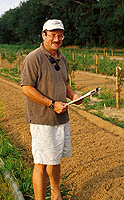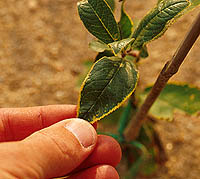
|
Beach Plum Research summary: Herbicide tolerance of beach plum (Prunus maritima) for commercial cultivation | |
Home page Andrew Senesac conducting herbicide safety tests on beach plum at Cornell University's Long Island Horticulture Research Lab. |
A. F. Senesac, afs2@cornell.edu Cornell Cooperative Extension, Riverhead, NY Caution: Herbicide treatments used in this experiment were for research purposes only. They are not recommendations. Follow all label instructions precisely when using herbicides. For more information, see Cornell Pest Management Guidelines for Commercial Tree-Fruit Production. A cooperative effort among growers and researchers is underway to determine if Beach plums (Prunus maritima) can be commercially cultivated. One of the barriers to efficient production is lack of adequate weed control. These studies were conducted to determine if young beach plum transplants can tolerate commercially available herbicides that are already registered for other tree fruit species. In one study, (Table #1) seedling beach plums were planted in the field in the spring of 2001. In 2001 and again in 2002, four herbicides were applied at 1/2X, 1X and 2X normal label rates. The herbicides evaluated: napropamide, simazine, oryzalin and fluazifop-p (2001 only) are already registered for use on domestic plums (Prunus domestica). The results of two years of application indicate a relatively high rate of tolerance to these herbicides. The exception being that the highest rate of simazine did cause visible injury symptoms.
The results of these studies suggest that some of the weed management tools that are currently available for domestic plums and other tree fruit crops can be safely employed for commercial Beach Plum production. |
